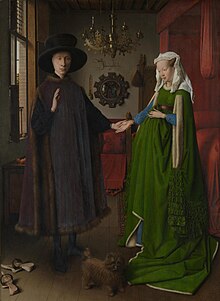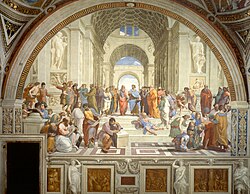

| Renaissance |
|---|
 |
| Aspects |
| Regions |
| History and study |
The Northern Renaissance was the Renaissance that occurred in Europe north of the Alps. From the last years of the 15th century, its Renaissance spread around Europe. Called the Northern Renaissance because it occurred north of the Italian Renaissance, this period became the German, French, English, Low Countries and Polish Renaissances, and in turn created other national and localized movements, each with different attributes.
In France, King Francis I imported Italian art, commissioned Italian artists (including Leonardo da Vinci), and built grand palaces at great expense, starting the French Renaissance. This included not only the then Kingdom of France but also the adjacent Duchy of Burgundy. Trade and commerce in then Burgundian cities like Bruges in the 15th century and Antwerp in the 16th increased cultural exchange between Italy and the Low Countries; however in art, and especially architecture, late Gothic influences remained present until the arrival of Baroque even as painters increasingly drew on Italian models.[1]
Universities and the printed book helped spread the spirit of the age through France, the Low Countries and the Holy Roman Empire, and then to Scandinavia and Britain in the early 16th century – a process halted by the religious schism caused by Henry VIII who had earlier extensively employed Italian artisans at Nonsuch Palace and Hampton Court under Thomas Wolsey. Writers and humanists such as Rabelais, Pierre de Ronsard and Desiderius Erasmus were greatly influenced by the Italian Renaissance model and were part of the same intellectual movement. During the English Renaissance (which overlapped with the Elizabethan era) writers such as William Shakespeare and Christopher Marlowe composed works of lasting influence. The Renaissance was brought to Poland directly from Italy by artists from Florence and the Low Countries, starting the Polish Renaissance.
In some areas the Northern Renaissance was distinct from the Italian Renaissance in its centralization of political power. While Italy and Germany were dominated by independent city-states, most of Europe began emerging as nation-states or even unions of countries. The Northern Renaissance was also closely linked to the Protestant Reformation with the resulting long series of internal and external conflicts between various Protestant groups and the Roman Catholic Church having lasting effects.
- ^ Janson, H.W.; Anthony F. Janson (1997). History of Art (5th, rev. ed.). New York: Harry N. Abrams, Inc. ISBN 0-8109-3442-6.